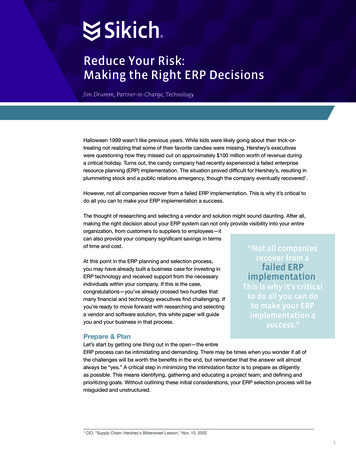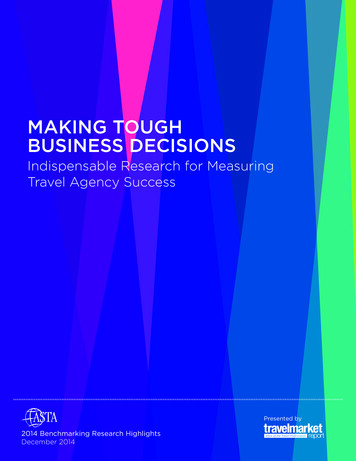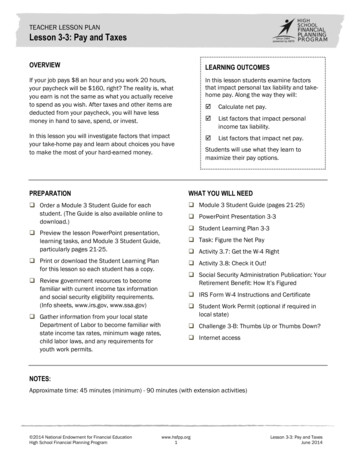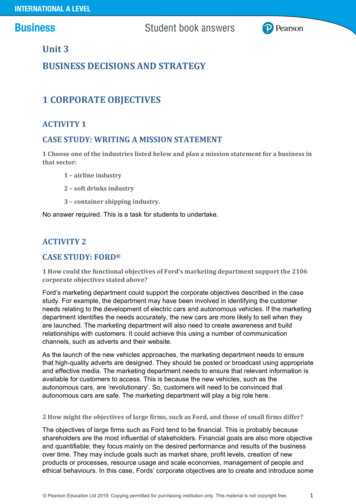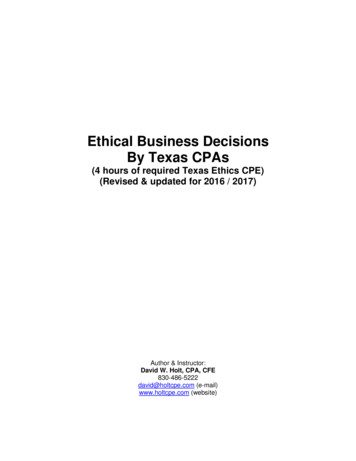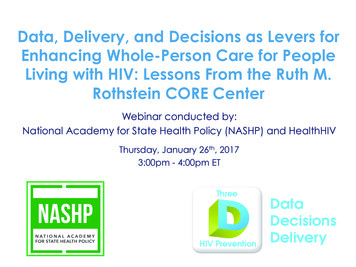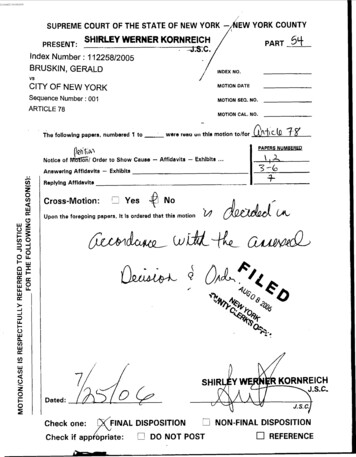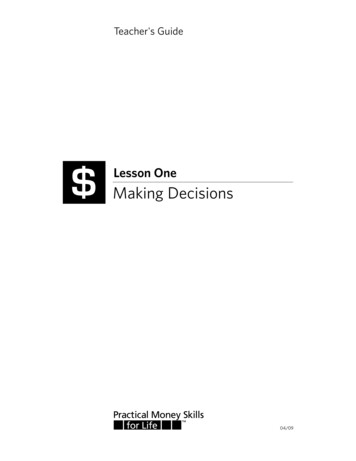
Transcription
Teacher's Guide Lesson OneMaking Decisions04/09
making decisions websitesDecision-making skills are something we use every day. We make choices aboutmany aspects of our lives from nutrition to money. To make the best financialdecisions, it’s important to have current information, assistance, and data on all ofthe relevant economic factors.For related links and resources on this lesson, lmoneyskills.com making decisionsteacher’s guide 1-i
making decisions lesson outlineoverviewEach day, we are faced with many decisions. While most decisions are simple, such as “whatshould I wear?” or “what should I eat?,” others are more complex, such as “should I buy a new or usedcar?”As decision-making skills are used and improved, a person’s quality of life is enhanced. Wiserchoices result in better use of time, money, and other resources.This introductory lesson provides students with an opportunity to learn more aboutdecision-making. The lesson starts with an overview of the decision-making process followedby a discussion of various internal and external factors that affect decisions.People are usually not aware of economic influences that can affect decision-making. Theseeconomic factors include inflation, interest rates, and the unemployment rate. Also, commonrisks associated with decision-making are often not considered. Students should also be aware ofopportunity cost—what a person gives up when a decision is made.Finally, the lesson concludes with strategies for analyzing the results of decision-making. Studentsare encouraged to consider their experiences in an effort to improve the quality of future decisions.goalsProvide an understanding and an awareness of the factors that can influence decisions,introduce basic decision-making methodologies, and provide structured practice in analyzinga problem, identifying options, and making a decision.lesson objectivesnIdentify decisionsnnnIdentify the steps in the decision-making processIdentify and explain factors that can affect the decision-making process, and give examplesof decisions that have been influenced by one or more of these factorsIdentify and explain frequently used decision-making strategies, and give examples ofwhen these strategies have been usednAnalyze influences of economic conditions on personal and financial decisionsnIdentify risks and opportunity costs associated with personal and financial decisionsnPractice making decisions using a decision-making diagrampresentation slides1-Athe decision-making process1-Bfactors that can influence a decision1-Ccommon decision-making strategies1-Deconomic influences on decision-makingwww.practicalmoneyskills.com making decisionsteacher’s guide 1-ii
making decisions lesson outline1-Erisks associated with decision-making1-Fopportunity costs and the time value of moneystudent activities1-1What Are You Trying to Decide?nn1-2Discuss how well they think their strategies have workednDiscuss what factors might have influenced their choice of strategiesHow Do Economic Conditions Affect Decision-Making?nResearch current economic conditions and determine possible effects on personaland financial decisionsDiscuss what actions might be taken based on various economic conditionsCan You Analyze a Decision?nn1-5As a class, have students identify and role-play the various decision-making strategiesthey’ve usednn1-4Have them use the decision-making process sheet to work through one of thedecisions they have identifiedWhat Decision-Making Strategies Have You Used?n1-3Have students identify three decisions they are trying to make (e.g. taking a vacation,moving away from home, buying a car, changing jobs, etc.)Ask students to volunteer to record one or more of their favorite televisionprogramsUsing the recorded television programs, have students identify the decision-makingstrategies being used by the main charactersnHave students document the decision-making process using the sheet providednDiscuss how well each strategy workedLesson One QuizFor more information, please refer to the Appendix.www.practicalmoneyskills.com making decisionsteacher’s guide 1-iii
making decisions target audiencesLearning activities appropriate to varied target audiences for lesson oneactivityteenagers(14-18)young adults(19-25)adults(26 )Survey/InterviewStudent Activity 1-1Student Activity 1-2Oral PresentationStudent Activity 1-3Web ActivityStudent Activity 1-4Lesson One Quiz 1-5www.practicalmoneyskills.com making decisionsteacher’s guide 1-iv
making decisions teaching notesdiscussionthe decision-making process (an example)1.Identify the problem or goal.n2.Where to live when you graduate fromhigh school/collegeObtain information and think about possible courses ofaction or possible alternatives.nnnnnnnnLive at homeLive at home and pay rent to parentsRent an apartmentLive aloneShare an apartmentLive in college dormLive in fraternity or sororityLive with friends or relatives3.Consider the consequences of each choice (action)and evaluate the alternatives.4.Select the best course of action.5.Evaluate the results.what are you trying to decide?1. Make a list.TeenagersnnnGoing to collegeSaving moneyGetting a part-time jobsurvey/interview:Talk to people about thebest and worst decisionsthey have made in theirlives.slide 1-Adiscussionstudent activity 1-1Young AdultsnnnBuying a carSaving moneyMoving away from homeAdultsnnnn2.Purchasing a homeSaving moneyChanging careersSelecting a retirement locationUse the decision-making process sheet to arrive at apossible solution for one of the decisions on the list.nTalk about the resultswww.practicalmoneyskills.com making decisionsteacher’s guide 1-v
making decisions teaching notesdiscussionwhy is this (sometimes) so hard?1.Levels of the cognitive domain:nnnnnKnowledge (easiest)Comprehension (less easy)Analysis (starting to get difficult)Synthesis (difficult)Evaluation (most difficult)factors that can influence a decisionnAgenBudgetnCulturenFamily opinionsnFeelingsnHabitsnPeersnRisks and consequencesnTimenValuescommon decision-making strategiesFor each strategy, discuss what it is, what recent decisionshave been made in that manner, and what factors influencedthe decisions to use that esisdiscussionslide 1-Bdiscussionoral presentation:Have students present inclass (or on video)examples of strong andweak decision-makingstrategies.slide 1-Cstudent activity 1-2www.practicalmoneyskills.com making decisionsteacher’s guide 1-vi
making decisions teaching noteseconomic factors and decision making1.Higher prices result in more expensive goods andservices and lower buying power of the dollar.2.Increases in consumer spending for certain goods andservices can result in additional jobs and higher wages inthose industries.3.Lower interest rates encourage consumer spending;higher rates are likely to encourage saving and lessborrowing.4.A higher money supply will usually result in lowerinterest rates. A lower money supply will likely result inhigher interest rates and reduced consumer spending.5.High unemployment reduces consumer spending andresults in fewer job opportunities.6.Increased home building usually leads to more jobopportunities and expanded consumer spending.7.A growing GDP usually indicates expanded economicgrowth in a country.8.Higher stock prices usually indicate confidence in theeconomy and strong business conditions for jobs andconsumer spending.risks and decision-makingopportunity costs and time value of moneyanalyze a decisionIf possible, use recorded programs (from televisions ormovies).nnnHave students identify the decision-makingstrategies being used by one or more of themain characters.student activity 1-3web activity:Conduct a web searchto obtain currentinformation on interestrates and inflation.slide 1-Dslide 1-Eslide 1-Fdiscussionstudent activity 1-4Have students document the decision-makingprocess using a decision chart.Discuss how well each strategy worked.lesson one quizwww.practicalmoneyskills.com making decisionsquiz 1-5teacher’s guide 1-vii
lesson one quiz: making decisionsanswer keytrue-falsefThe decision-making process starts with gathering information.1.f2.Procrastination is an example of an economic influence on decision-making.t3.Higher interest rates result in higher costs of borrowing money.4.t5.tRising prices causing lower buying power is referred to as an inflation risk.Interest earned on savings may be referred to as the “time value of money.”multiple choice6.AC. taxes riseThe final step of thedecision-making process is:A. evaluating the resultsB. gathering informationD. people are putting moremoney into savings accounts9.DC. identifying the problem7.CD. selecting the best courseof actionB. the money supplyC. the consumer price index8.BA. inflationB. economicChanges in the buying powerof the dollar are measured by:A. the unemployment rateInvestments that may be difficult toconvert to cash quickly have a highrisk.C. incomeD. liquidity10. CWhat a person gives up when makinga decision is commonly called:D. interest ratesA. the time value of moneyConsumer spending is likelyto rise when:C. an opportunity costA. unemployment is highB. a personal riskD. spontaneityB. interest rates are lowcase applicationIn recent weeks, Richard and Fran Jones have considered moving to another city with additionaljob opportunities. Discuss the personal and economic factors they might consider in this situation.What risks are associated with this decision? Personal factors that the Joneses may consider include theirjob skills, willingness to move with regard to family and friends, and personal long-term goals. Economicfactors might include the employment opportunities in the new city, and the cost of living compared to thesalary level. Risks that might be associated with this situation include current and new job satisfaction, andthe effect of economic conditions on current and future employment opportunities in the new city.www.practicalmoneyskills.com making decisionsquiz key 1-5
Student Activities Lesson OneMaking Decisions04/09
name:date:what are you trying to decide?Identify the problem Gather information and list possible alternatives Consider the consequences of each alternative Select the best course of action Evaluate the results www.practicalmoneyskills.com making decisionsstudent activity 1-1
name:date:what decision-makingstrategies have you used?directionsAs a class, identify and role-play the various decision-making strategies you’ve used, then answerthe questions below.1. Have the strategies you’ve used worked? Please explain.2. What factors do you think might have influenced your choice of strategies?www.practicalmoneyskills.com making decisionsstudent activity 1-2
name:date:how do economic decisions affectdecision-making?Changing economic factors affect the decisions we make. Using The Wall Street Journal, internet, orother sources of economic news, obtain information about current economic trends that influencevarious saving, investing, spending, and borrowing decisions. For example, higher interest ratesmake borrowing more expensive; however, higher interest rates make saving more attractive.economic factorrecent trendspossible influenceson personal andfinancial decisionsInterest ratesConsumer pricesOtherOtherwww.practicalmoneyskills.com making decisionsstudent activity 1-3
name:date:can you analyze a decision?Identify the problem Gather information and list possible alternatives Consider the consequences of each alternative Select the best course of action Evaluate the results www.practicalmoneyskills.com making decisionsstudent activity 1-4
name:date:lesson one quiz: making decisionstrue-false1.The decision-making process starts with gathering information.2.Procrastination is an example of an economic influence on decision-making.3.Higher interest rates result in higher costs of borrowing money.4.Rising prices causing lower buying power is referred to as an inflation risk.5.Interest earned on savings may be referred to as the “time value of money.”multiple choice6.C. taxes riseThe final step of thedecision-making process is:A. evaluating the resultsB. gathering informationD. people are putting moremoney into savings accounts9.C. identifying the problemD. selecting the best courseof action7.A. inflationB. economicChanges in the buying powerof the dollar are measured by:C. incomeD. liquidityA. the unemployment rateB. the money supplyC. the consumer price index8.Investments that may be difficult toconvert to cash quickly have a highrisk.10.What a person gives up when makinga decision is commonly called:D. interest ratesA. the time value of moneyConsumer spending is likelyto rise when:C. an opportunity costA. unemployment is highB. a personal riskD. spontaneityB. interest rates are lowcase applicationIn recent weeks, Richard and Fran Jones have considered moving to another city with additionaljob opportunities. Discuss the personal and economic factors they might consider in this situation.What risks are associated with this decision?www.practicalmoneyskills.com making decisionsquiz 1-5
Teacher's Guide Lesson TwoMaking Money04/09
making money websitesLanding that first job is an exciting time, and there are many areas to considerbefore the first paycheck is earned. Students should explore career path optionsand understand all of the financial aspects of employment.For related links and resources on this lesson, lmoneyskills.com making moneyteacher’s guide 2-i
making money lesson outlineoverviewBuilding your career is one of the surest ways to increase income and make money. Whenplanning for the future, one of the most critical financial decisions is determining your career path.In this lesson, students will be encouraged to consider various topics related to career planningand the financial aspects of employment. This variation of the decision-making process can help aperson match personal abilities and interests with appropriate employment opportunities.“How does a person apply for a job?” This is a question asked by many students. First studentsare informed of sources for identifying available employment positions. Next, various aspectsof interviewing are discussed, as well as information on preparing for a job interview alongwith tips for successful interviewing.Then, financial aspects of employment are considered, including the "hidden costs" ofworking and employee benefits. Finally, for students who have not worked in the past,information is offered about payroll taxes and other deductions from a person’s income.goalsGain an understanding of career planning and the processes of employment, tips on starting anew career and provide practice reading and interpreting pay stubs.lesson objectives Know the phases of the career-planning process Identify and apply for employment Understand the interview process Understand some of the hidden costs of a job Understand some of the benefits companies often offer employees Interpret a pay stubpresentation slides2- Athe career planning process2- Bpreparing for a job interview2- Ccommon interview questions2- Dadding up the benefits2- Ereading a pay stub2- Fan example of paycheck deductionswww.practicalmoneyskills.com making moneyteacher’s guide 2-ii
making money lesson outlinestudent activities2-1Assessing Your Personal Interests and Abilities2-2Evaluating the Current Employment Market Part-time summer employment Career-entry positions Advanced careers, employment field changes2-3Creating a Resume2- 4Reading and Interpreting Pay Stubs2- 5 Have students answer the questions about the attached pay stubs Discuss their answersLesson Two QuizFor more information, please refer to the Appendix.www.practicalmoneyskills.com making moneyteacher’s guide 2-iii
making money target audiencesLearning activities appropriate to varied target audiences for lesson twoactivityteenagers(14-18)young adults(19-25)adults(26 )Student Activity 2-1Student Activity 2-2Student Activity 2-3Oral PresentationSurvey/InterviewStudent Activity 2-4Lesson Two Quiz 2-5www.practicalmoneyskills.com making moneyteacher’s guide 2-iv
making money teaching notesthe career planning process Phase 1: Assess your personal interests, abilities, andcareer goals. Phase 2: Evaluate the current employment market. Phase 3: Identify specific job opportunities.slide 2-Astudent activity 2-1Phase 4: Apply for employment positions with theuse of a resume or application letter. Phase 5: Interview for available positions. Phase 6: Obtain additional career training.identifying and applying for employment positions Advertisements Personal contacts Business organizations The internetstudent activity 2-2student activity 2-3web activity:Conduct a Web search toidentify sites that peoplecan contact to obtaininformation on availablejob positions.the interview processWhen preparing for a job interview, take the following actions:1.When researching an organization, obtain information on: 2.What are its main activities?What types of jobs does it have?What do the people who work there like abouttheir employment situation?Practice your interviewing skills: 3.slides 2-B & 2-CWrite out answers to possible interview questions.Have someone interview you.oral presentation:Have students present inclass (or on video) examplesof strong and weakactions in a job interview.Prepare questions that you plan to ask: What skills are needed for success in the organization?What opportunities are available for continuedlearning?www.practicalmoneyskills.com making moneyteacher’s guide 2-v
making money teaching notesthe hidden costs of a job1.Transportation2.Clothing UniformsNice clothing3.Food4.Child or adult care5.Union duesadding up the benefits1.Possible job benefits Health, dental, and eye care insuranceLife insurance/disability insuranceFlexible spending accountHealth savings accountTax-deferred retirement planPaid vacationPaid holidaysParental leaveStock purchase planEmployee assistance plansEmployee fitness programsEmployee discountsTuition assistance or reimbursementreading a pay stub1.Pay period2.Gross pay3.Wage deductionsdiscussionrework budgetcalculator:pmsfl.comdiscussionslide 2-Dsurvey/interviewTalk to people about theemployee benefits theybelieve to be mostimportant for their lifesituation.discussionslides 2-E, 2-F & 2-GFederal income taxFICA (Social Security and Medicare) Individual state or local income tax Tax-free or tax-deferred benefitsNet pay 4.www.practicalmoneyskills.com making moneyteacher’s guide 2-vi
making money teaching notesinterpreting pay stubs1.Interpret sample pay stubslesson two quizQuiz 2-5 is in the student activity section.The answer key is at Teacher's Guide page 2-ix.www.practicalmoneyskills.com making moneystudent activity 2-4quiz 2-5teacher’s guide 2-vii
read and interpret pay stubsanswer keydirectionsAnswer the following questions using the attached pay stubs:1. What is the name of Jane Brown’s employer?Hamburger Palace Enterprises, Inc.2. How much did Jane earn before taxes? 120.003. What is Jane’s salary? 6.00/hour4. List Jane’s deductions.Federal income tax, Social Security, Medicare, state income tax, meals5. What pay period does Peter Smith’s check cover?8/6/99 to 8/12/996. How much federal income tax has been taken out of Peter’s check so far during 1999? 429.847. How much did Peter contribute to a retirement plan from this paycheck? 30.008. How much is Peter’s take-home pay? 182.419. Where does Mary Stone work?Dance-o-Rama10. What is Mary’s salary? 448.0011. How much money was deducted from Mary’s paycheck? 98.7912. How much has Mary been paid in total during 1999? 5,824.00www.practicalmoneyskills.com making moneystudent activity key 2-4
lesson two quiz: making moneyanswer keytru
www.practicalmoneyskills.com making decisions teacher’s guide 1-i Decision-making skills are something we use every day. We make choices about many aspects of our lives from nutrition to money. To make the best financial decisions, it’s important to have current information, assi
